Have you ever been confused about what kind of salt to use in a recipe? Sea salt, kosher salt, Himalayan salt, table salt… there are so many kinds! What is the difference between kosher salt and table salt, can I use equal amounts of them? Can I substitute table salt for sea salt? Does salt expire? How can I reduce the sodium in my recipes and still have them taste good? Let’s dive into these common questions about salt so you can feel confident when seasoning your recipes.
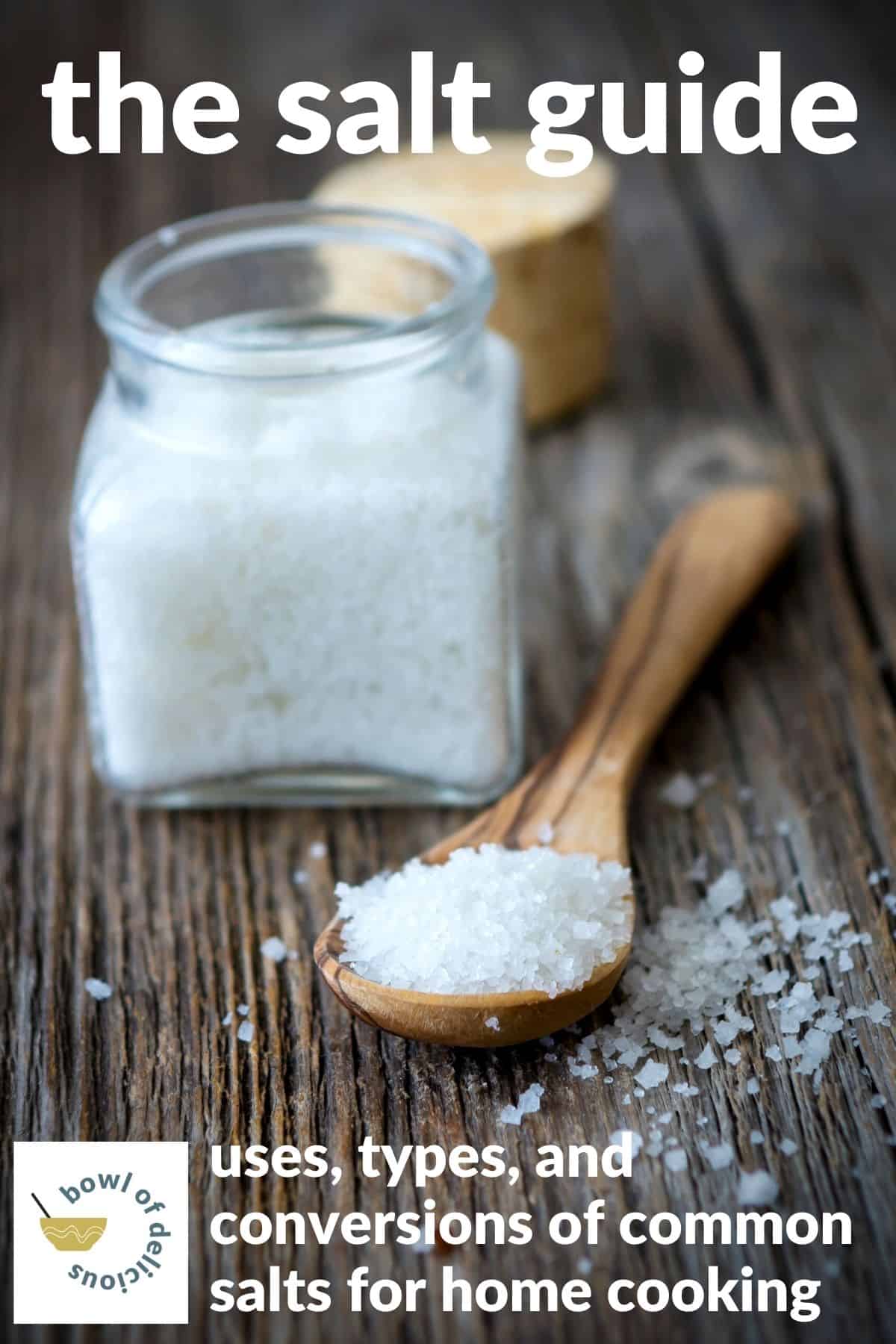
Table of contents
- What are the most common types of salt?
- What are the uses for different types/shapes of salt?
- What brand and type of salt do you recommend?
- Diamond Crystal vs. Morton Kosher Salt
- Salt Conversion Chart
- Does salt expire?
- Tips for reducing salt/sodium when cooking recipes
- TLDR: What is the best advice for using salt in recipes in a nutshell?
What are the most common types of salt?
Salts can vary greatly between types and shape. There is salt from the ocean, pink salt from caves in the Himalayas, and salt islands all around the world. They can come in various colors and some have different flavor profiles.
For home cooking, the most important thing is the shape of the salt. Why? Because different shapes have different densities, which can mean they are more suited for different uses and measurements.
Fine grain salts are smaller in size, and coarse are larger.
Here are some of the most common salts you’ll find in recipes and at your grocery store.
- Sea Salt is salt from, you guessed it, the sea. Sea salt is left behind after ocean water evaporates. It can be fine grain, coarse, or flaky. Baliene is a common brand, found in US grocery stores. It comes in both fine grain and coarse grain.
- Himalayan Pink Salt is a rock salt, harvested from Pakistan. Some people believe it’s healthier than other salts but there is no scientific research to support that. It’s a beautiful color, and it’s even used to make lamps, as well as slabs you can heat up to cook and season your food at the same time. It can be fine or coarse.
- Kosher Salt, like Morton and Diamond Crystal, was originally developed to kosher meats. Koshering is a method of preparing meats for those who follow a kosher diet. It’s now widely used in all kinds of recipes for its purity (lack of additives) and coarse texture. Kosher salt comes from the land, not the sea.
- Sea salt flakes, such as Maldon, have a very pure taste and the texture is flaky. They are made by evaporating the water from sea salt on top of a mold to a very thin layer, then flaked apart and packaged.
- Table salt is a fine grain salt. Morton is a common brand. It can be iodized or non-iodized.
- Iodized table salts are fortified with iodine, an essential nutrient. Iodine is also present in foods like shellfish, dairy, and other common foods. Iodized salt is great for populations who do not have reliable natural sources of iodine in their diets. I tend to stay away from it in my cooking because it can impart a metallic taste in foods, though it’s usually not very noticeable.
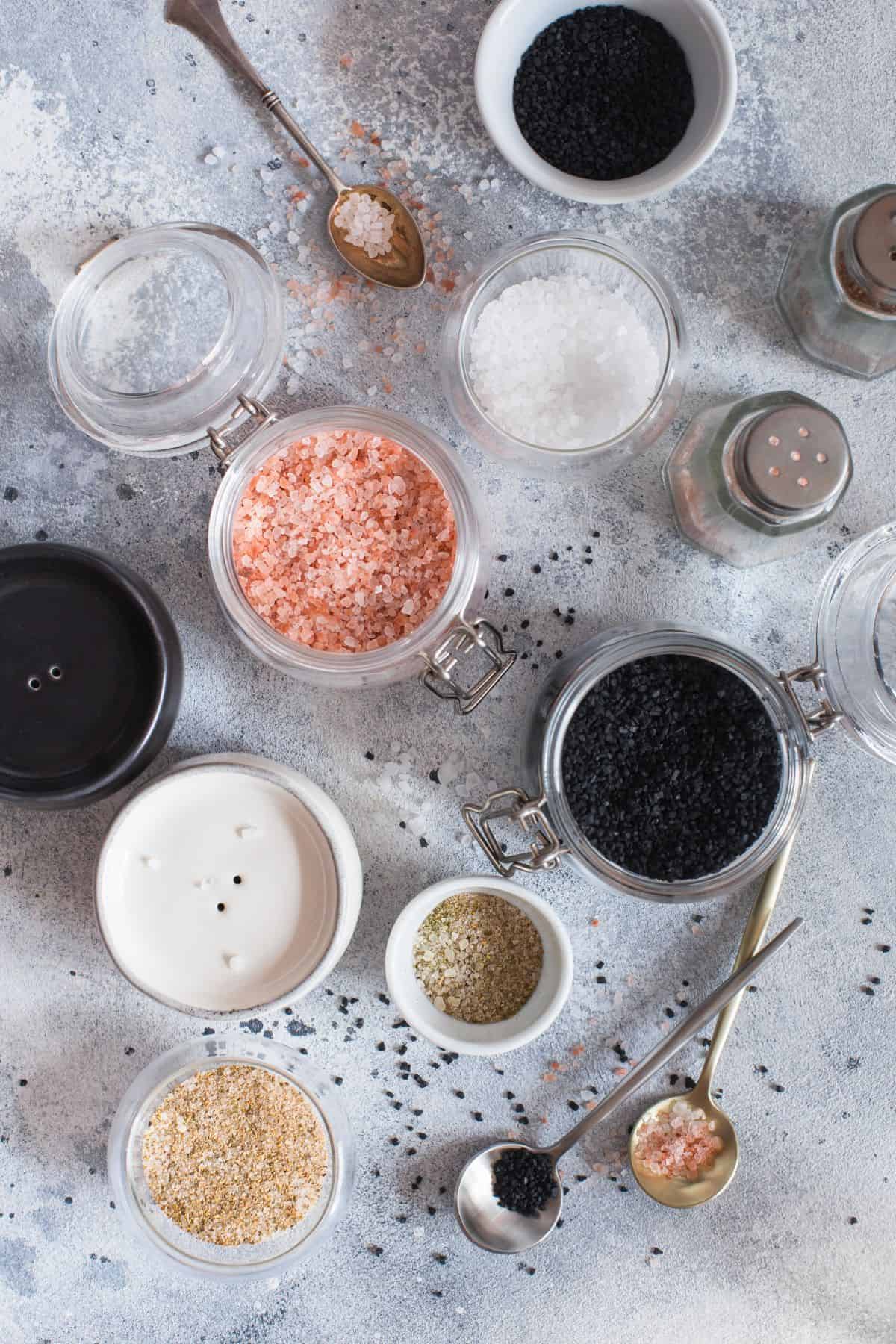
What are the uses for different types/shapes of salt?
Different types of salt have different shapes, which can mean more concentrated flavor for seasoning, different time that it takes to dissolve, etc.
- Fine grain salts are best used in baking, where you need the salt to disperse evenly throughout the food and there isn’t a lot of liquid to dissolve it. I usually use fine grain sea salt or pink Himalayan salt in bread baking, in cookies and muffins, etc.
- Kosher salt and smaller coarse salts are great for seasoning meat and other ingredients for searing or roasting. I use kosher salt to season roast chicken, searing salmon and other proteins, and tossing with veggies for roasting, such as brussels sprouts. I use it most commonly in my kitchen, in soups and stews and other recipes as well.
- Larger coarse salts are great for adding to a salt grinder.
- Flaked sea salt is good for a finishing salt – use it to sprinkle on top of cookies, a finished steak, on avocado toast, etc. It’s delicate in shape and more expensive, so I wouldn’t recommend using it to cook with.
What brand and type of salt do you recommend?
I personally use Morton kosher salt for almost everything and it’s the most common one you’ll find listed in the ingredients on Bowl of Delicious. I use Baliene fine sea salt or my grocery store’s brand equivalent when I bake. Both of these are reliably pure tasting and affordable for what you get.
Diamond Crystal vs. Morton Kosher Salt
To add complication to the matter, all kosher salts are not the same. There is a HUGE difference between the two major brands, Diamond Crystal and Morton Kosher salts. Diamond Crystal salt has a rounder shape that results in much less sodium per volume than its flatter cousin by Morton, meaning you need almost DOUBLE the amount of Diamond Crystal salt than you need for Morton!
Personally, I use Morton kosher salt. So when you see “kosher salt” in my recipes, that’s the brand I’m talking about. But if you every come across a recipe in the wild that requires kosher salt, you may want to take a peek at the recipe notes or introduction to the cookbook to see if the writer specifies which brand. Ina Garten, for example, uses Diamond Crystal kosher salt, and I’ve made recipes of hers with my Morton salt to extremely salty results. I have to remember to take it down a notch when seasoning her recipes.
Salt Conversion Chart
Here’s a handy salt conversion chart for some of the most popular types and brands of salt. The only big difference with brands is Diamond Crystal vs. Morton Kosher salts. In general, your fine sea salts, Himalayan salts, etc. will be similar between brands. The information in this chart is from my own kitchen weighing and experiments, info around the web, and my best estimates.
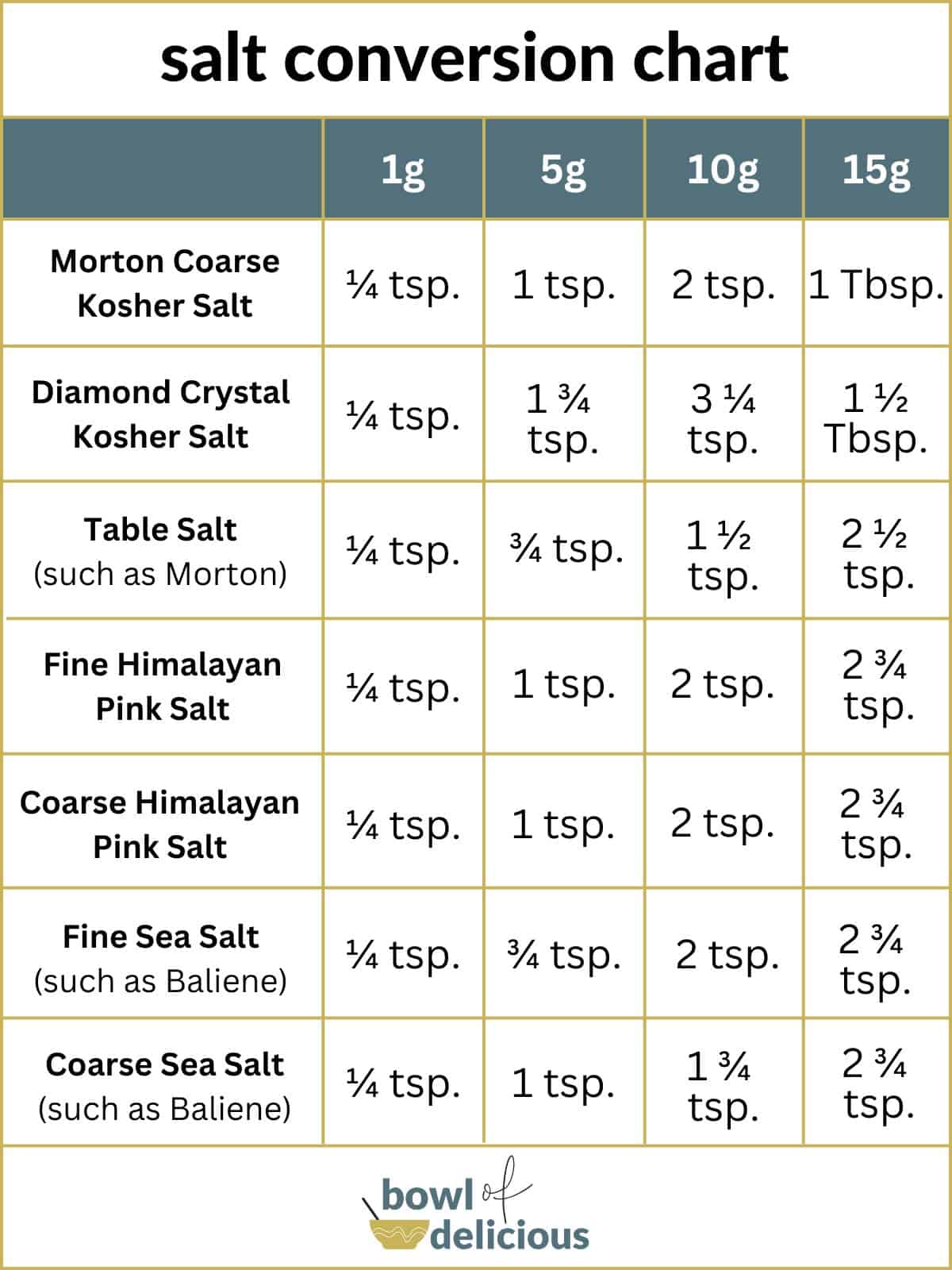
Does salt expire?
This is kind of a trick question. Salt is MILLIONS of years old, a mineral found in caves and the ocean and in the earth. So technically, salt itself lasts forever.
That said, most store-bought salt for cooking often comes with some kind of an addition, like an anti-caking agent (this causes it to not clump together). That anti-caking agent can start to lose its effectiveness after about 5 years. While the salt will still be safe to use, you may find that it starts to clump together over a long period of time. Iodized salt also has iodine added to it that can lose its potency over time.
Even if you have a pure salt without any additions like an anti-caking agent, over time, the salt may begin to clump together from exposure to moisture and temperature changes, making it harder to use.
In summary, while salt doesn’t technically expire, and it will be safe to use practically forever, its quality may deteriorate after a few years.
Tips for reducing salt/sodium when cooking recipes
Many people want to reduce their sodium intake for health reasons. Here are my tips for reducing sodium in your diet without sacrificing taste.
- Cook from scratch whenever possible. Prepared and processed ingredients contain exorbitant amounts of sodium. For example, making your own chicken broth instead of using store-bought or boullion will drastically reduce the sodium in your soups. It’s surprising how much salt can be in prepared ingredients!
- Use citrus! A squeeze of lemon juice or lime juice will bring out flavors of ingredients in a similar way to how salt brings out natural flavors in foods. Add a squeeze of lemon juice or lime juice to soups, meats, rice dishes, tacos, and countless other things. It’s best to do this just before serving so the flavor is more potent.
- Use less added salt and more other spices. Amp up the flavor of your dish with spices from your pantry, fresh herbs, etc.
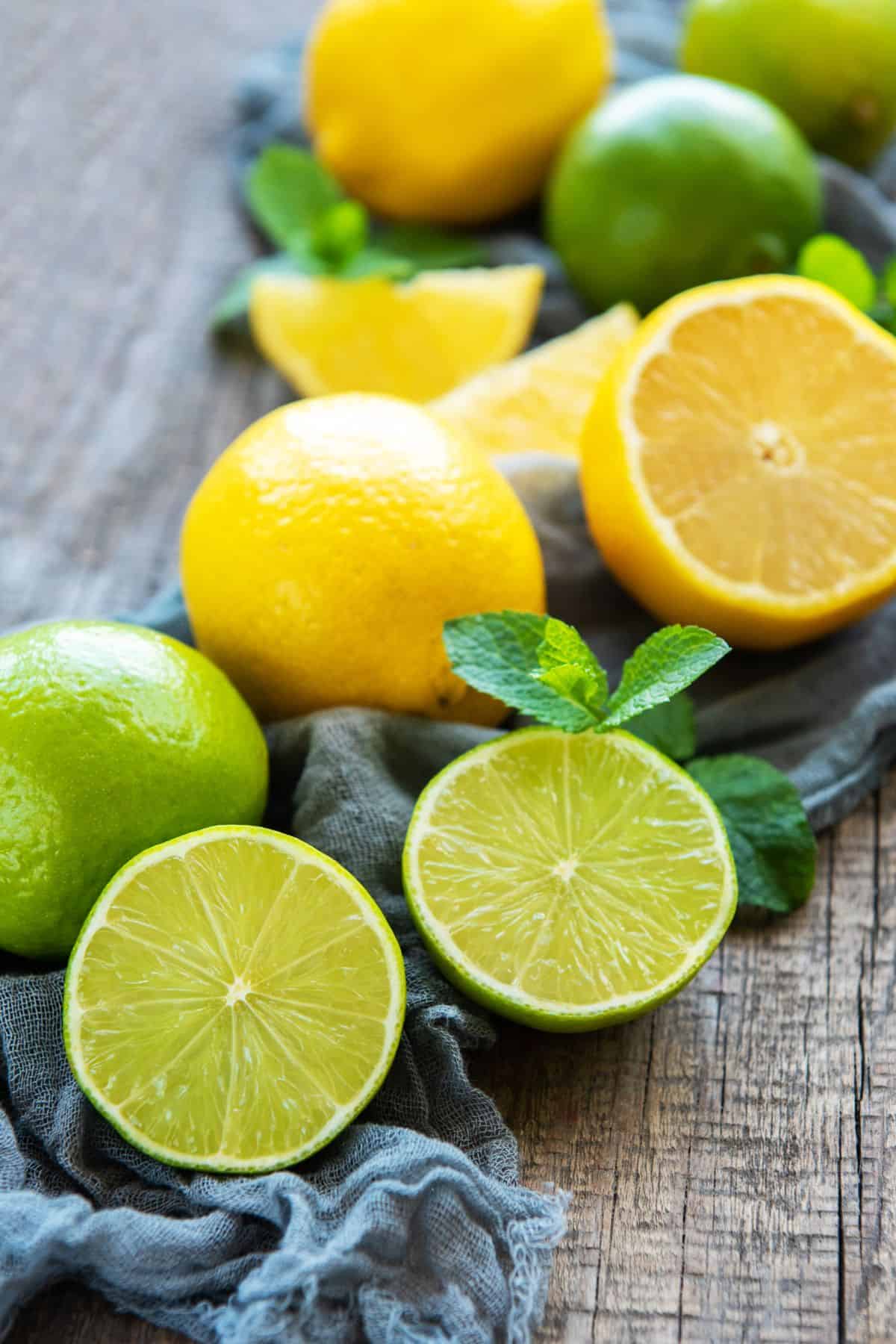
TLDR: What is the best advice for using salt in recipes in a nutshell?
Here’s my biggest advice when using salt.
Different salts contain more sodium per volume depending on the shape of the grain. My advice? Pick a salt and get used to it for your specific tastes. A recipe that calls for 1 teaspoon of Kosher salt will only be so helpful for you if you just have fine grain sea salt! In addition, your tastes may be different than the person writing the recipe – some people like salty flavors more than others.
Personally, my salt of choice is Morton Coarse Kosher Salt. When baking bread and sometimes cookies, muffins, etc., I usually use fine grain sea salt.
If you keep using whatever salt you have again and again when you cook, you’ll get used to how it works, what you like, and you’ll be able to adjust the amount like a pro in no time!
Do you have any salt wisdom to add to this? Please comment below with anything you’d like to add or questions you have!
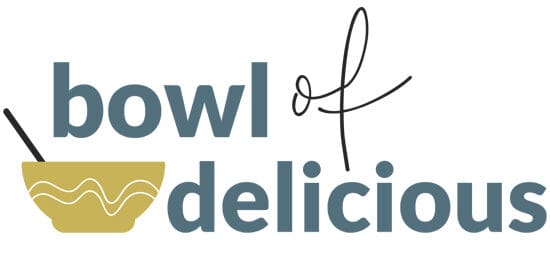



Schane
I find if I can’t see anywhere in the cookbook that they use diamond or Morton’s kosher salt. I just rely on what part of the country they’re from since the East Coast primarily uses the diamond kosher salts.
Elizabeth Lindemann
Well I’m on the east cost and I use Morton primarily! But that’s interesting, I hadn’t heard that before.
Janie Teague-Urbach
i have to cut way back on my salt, as my blood pressure has shot way up. I am limited to 1/2 the reccomended daily amount. As you pointed out, that is really difficult if you buy processed foods. For savory dishes, it’s not so bad, I use Mrs. Dash or Bell’s seasoning or other saltless spice and herbal mixtures and lemon juice as you suggest. My problem is things like hot cereal. Without the taste of salt, they are really bland, most of them. I use coconut sugar and that helps a bit – it adds some flavor. But do you have any ideas for substitutes for salt in sweet or at least not savory disthes?
Thanks, you are my go to cooking person as I am new to this. My late husband was an awesome cook and I didn’t need to, but he also liked your recipes, although he didn’t NEED them like i do.
Janie
Elizabeth Lindemann
Hi Janie! I’m not an expert on salt alternatives and that area of nutrition, but I do have some ideas. I think some sweet things are “just sweet” and lack other flavors. Think sugar cookies. But other sweet things have cinnamon and nutmeg, or lemon or orange, or a high fat content, that can add some interesting flavors and textures. I think you may want to focus on those kinds of recipes. I love doing oatmeal by sautéing apples in butter, cinnamon, and sometimes nutmeg, then adding the oats with water and a pinch of salt (which can be left out) and cooked that way. The spices, apples, and fat from the butter all help add a lot of flavor. You may want to also consider lessening the salt in sweet things by omitting it in the recipe (unless you are baking something finicky that needs salt to work), and instead using a finishing salt like Maldon to help bring a very fresh and potent salt flavor without having it permeate the entire thing. Hope that helps a bit, and it may be worth running these ideas by a nutritionist or doctor <3
Thank you for your kind words about my recipes, and I'm sorry to hear about your husband. Sending you strength ❤️ -Elizabeth
Rebecca
Hi, I followed the recipe exactly as stated but I did not get a sticky dough. I had to add water….it is sitting covered for a couple of hours before I can bake it. What happened?
Elizabeth Lindemann
It could be that the flour you used was a bit “thirstier” and required more water, or that it just needed a bit more mixing. You did right by adding more water! Hope it turned out well for you.